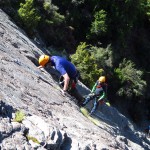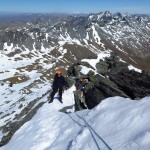New Zealand sits in the Roaring forties – the trade winds that blow from west to east under Australia. During the changes of the season and in particular Winter – Spring – Summer we get what is often called a disturbed westerly flow.
This is when an approaching low brings a strong flow of NW winds – often associated with storms and strong to gale force winds. In ideal conditions, as the low moves off to the east of NZ the following area of high pressure extends a stabilizing ridge of high pressure over the NZ islands, bringing clear calm skies and good weather – these are the weather windows we are looking for to get out into the mountains and go climbing.
 In a El Nino pattern (or disturbed westerly flow) the Highs no longer ridge across NZ but instead the centre of the high turns to the north east over the Tasman Sea and basically misses the majority of New Zealand.
In a El Nino pattern (or disturbed westerly flow) the Highs no longer ridge across NZ but instead the centre of the high turns to the north east over the Tasman Sea and basically misses the majority of New Zealand.
LINK
Strongest El Nino in decades – Weather Watch
The overall effect?
Winds turn from North West to South West and then back to NW with the approach of the next low without any appreciable period of stable settled weather.
Typically this pattern lasts for spring and at times extends into summer. In stronger El Nino events (such as the one seemingly predicted for this summer season) it may last or extend into middle or late summer – the West Coast get more rain whilst the East coast often enters a strong drought.
What does this mean for NZ Mountaineering? Often periods of waiting out strong winds to get into the mountains and then making the most of short windows to go climbing.
Sometimes, like the last trip I was running – a alpine instruction course – we get ‘out of sync’ with the weather which ends up meaning that the weather will not allow us to get into the hills – or when it does – the window is so short and our guests time frames mean that its not practical to even make the attempt. In such cases we make every effort to do training on rock or in other venues that don’t require air access etc.
The Remarkables (near Queenstown) offer a great venue for alpine training programs – good campsites and easy retreats in the face of gale force winds and heavy rains.
The gallery below are from the trip last week which, unfortunately ended up being caught in the worst possible cycle of bad weather timing and guests with very tight time frames for work and flights home.
After 2 days of rope skills and rock skills based in Mt Cook – we waited for a clearance to get into the head of the Tasman Glacier – when this didn’t eventuate we relocated south to the Remarkables for snow craft skills and pitching before again relocating to Wanaka for training on rock to allow the guys to learn some rigging and climbing skills that would allow them to get out on the crags and cliffs close to where they live












